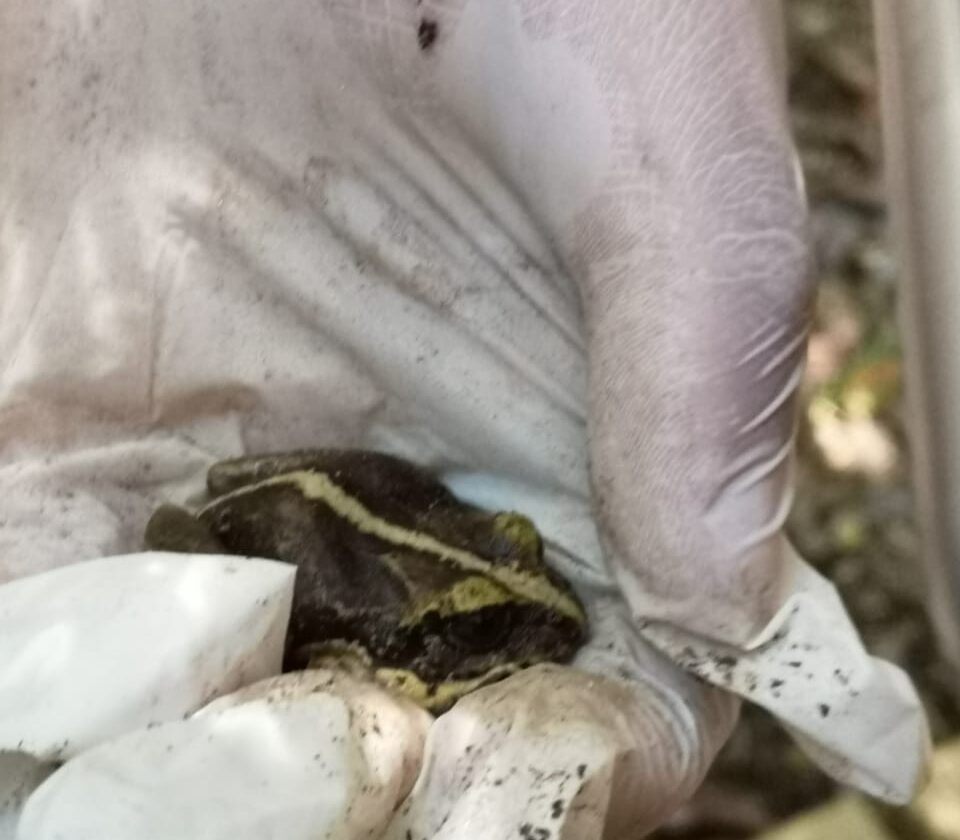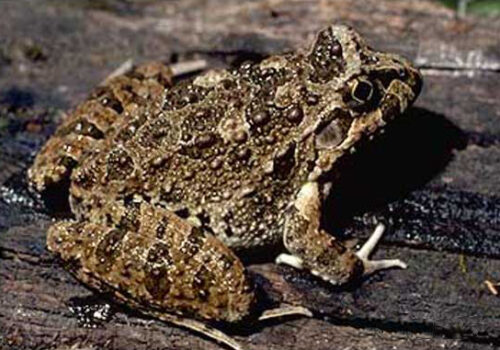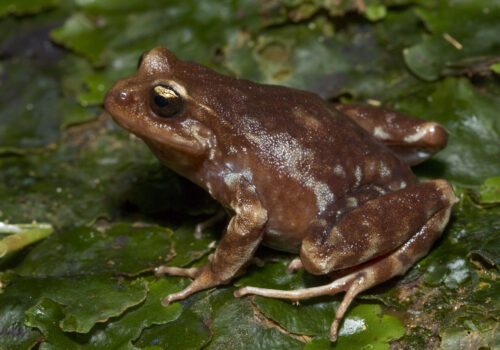Eupsophus vertebralis: Discovering Chile’s Secretive Jewel of the Forest Floor#
In the mist-laden, temperate rainforests of southern Chile, nestled amid layers of decaying leaf litter and lush moss carpets, lives a small, cryptic amphibian—Eupsophus vertebralis. Known commonly as the Valdivian ground frog, this elusive species quietly thrives, often unnoticed by casual observers who explore these ancient woodlands. Its mesmerizing camouflage, coupled with intriguing behavior, makes it a compelling ambassador for the biodiversity hidden within the shadows of Patagonia’s remote forests. While most envision frogs perched agilely on tree branches or loudly croaking beside ponds, Eupsophus vertebralis breaks convention—choosing instead the art of stealth and subtlety as its way of life.
Although relatively unknown to the broader world, this charming amphibian harbors fascinating characteristics and behaviors that enchant naturalists, inspire conservationists, and offer scientists valuable insights into southern Chile’s sensitive ecosystems. Let’s embark on a journey beneath the dense canopy to meet one of the region’s most enigmatic and captivating frogs.
Taxonomy and Classification#
Eupsophus vertebralis belongs to the family Alsodidae, a family uniquely adapted to the cool, humid habitats found throughout Patagonia and the southern Andes region. The genus Eupsophus itself is known collectively as ground frogs, reflecting their typically terrestrial lifestyle. Documented scientifically by Philippi in 1902, the species epithet “vertebralis” is drawn directly from a prominent dorsal pattern reminiscent of a vertebral line along its back—an identifying trait immediately setting it apart from its close relatives.
The genus Eupsophus comprises several species, each uniquely adapted to slight variances within their habitat. However, Eupsophus vertebralis maintains a distinct identity, clearly discernible by its dorsal markings and habitat preference, allowing it to thrive in the specific microclimatic conditions provided by its southern Chilean rainforests.
Natural Habitat#
Geographic Distribution#
Restricted primarily to southern Chile, Eupsophus vertebralis occupies a remarkably limited geographic range spanning the temperate Valdivian rainforest ecosystem. From the coastal forests near the city of Valdivia southward toward Chiloé Island, this nocturnal frog gracefully navigates a mosaic landscape characterized by temperate rainforests, humid ravines, and misty evergreen woods.
Microhabitat Preferences#
This amphibian prefers the humid, shaded understory environments, specifically areas teeming with organic material: fallen leaves, rich moist humus, dense fern understories, and decaying logs that retain moisture even during periods of drier weather. Within this unique ecological setting—a canvas painted with ancient trees like coihue, alerce, and luma, wrapped in moss—Eupsophus vertebralis shelters discreetly beneath leaf litter, making elusive appearances only at night or during persistent rains.
Interactions within its Environment#
The microhabitat preference of Eupsophus vertebralis provides immense ecological value: these frogs help regulate insect populations and serve as significant prey for reptiles, birds, and mammals native to these moist forests. Their meticulous sheltering strategy beneath layers of decaying leaves and logs also facilitates nutrient cycling, connecting soil organisms to the broader ecosystem, indirectly influencing plant growth and soil fertility.
Physical Characteristics#
Eupsophus vertebralis exhibits cryptic beauty. Typically small, averaging around 30 to 40 millimeters in length, its stout body blends remarkably within the brown and orange mosaic of the forest floor. The most striking attribute is its dorsal coloration—rich shades of brown to cinnamon orange, highlighted by a bold mid-dorsal stripe running longitudinally down its body. This clearly defined stripe, reminiscent of a spine, inspired the species’ scientific name—vertebralis.
The skin texture is smooth yet slightly granular, imparting a perfect mimicry of surrounding fallen leaves, detritus, and moss pads. Similar hues recast subtle but effective camouflage—an essential adaptation protecting them from predators. Prominent dark markings, including bands or blotches along limbs and flanks, further enhance their cryptic prowess.
Eyes large and generously proportioned relative to the head size facilitate excellent nocturnal vision, vital for hunting many active twilight or nighttime invertebrates. Powerful rear limbs reflect their exceptional jumping ability—though they use this sparingly, preferring subtle crawling movements through their leafy tunnels.
Behavior and Life Cycle#
Feeding Habits and Diet#
Like many amphibians, Eupsophus vertebralis primarily feeds on small insects, arachnids, and other tiny invertebrates. Nocturnal by nature, it emerges quietly from beneath logs and leaf litter after dusk, patiently waiting to ambush prey passing unsuspectingly nearby. Equipped with exceptional vision optimized for low-light conditions, this frog deftly tracks movements, capturing prey swiftly with its sticky tongue. Subtle yet significantly influential ecological actors, their selective insect predation helps balance populations of forest-floor arthropods.
Breeding and Parental Care#
Eupsophus vertebralis displays fascinating reproductive behaviors, hallmarking the genus Eupsophus—a lineage notable for unique reproductive strategies. Mating typically occurs during the wetter season, when conditions optimize survival chances for offspring.
Distinctive and relatively quiet mating calls, a soft series of ascending whistles, resonate subtly beneath the forest canopy. Males vocalize discreetly from hidden locations under organic debris to attract responsive females seeking reproductive partners. Once paired, females lay a modest clutch of terrestrial eggs, carefully deposited in protected, moist microhabitats such as beneath logs or sheltered cavities in soil.
Remarkably, the male takes on an unusual level of paternal responsibility, guarding the precious egg clutch against predators and drying-out. Upon hatching, rather than immediately becoming free-swimming tadpoles, larvae remain terrestrial in moist burrows until maturation—a striking divergence from classic amphibian life cycles and critical adaptation to their niche environment.
Ecological Role#
Eupsophus vertebralis occupies a vital ecological role within the temperate rainforest ecosystem it calls home. Serving as both predator and prey, this small amphibian creates balance within forest-floor communities. By feeding selectively on insects and arthropods, it contributes substantially to pest regulation, indirectly supporting plant communities and soil organisms. Simultaneously, this species provides critical sustenance for larger predators—forest birds such as thrushes and owls, reptiles, and small mammals that rely on it as an essential nutritional resource.
Equally essential, as a sensitive species adapted specifically to moist, undisturbed habitats, this frog is a valuable bioindicator. Its presence reliably signifies intact, stable ecosystems, signaling health and environmental quality to conservation scientists closely monitoring these delicate rainforest habitats.
Threats and Conservation Status#
Eupsophus vertebralis occupies habitats increasingly exposed to anthropogenic threats. Habitat loss and fragmentation resulting from agricultural expansion, logging, infrastructure development, and urbanization remain significant challenges. Climate change compounds these pressures, altering rainfall patterns and threatening moisture-dependent forests critical to their survival.
Currently, according to the International Union for the Conservation of Nature (IUCN), Eupsophus vertebralis is listed as “Near Threatened.” Given its restricted distribution, continuing habitat alteration poses serious conservation concerns, urging immediate action toward habitat preservation and careful management practices focused on maintaining crucial ecosystem processes.
Cultural and Scientific Significance#
Despite limited public recognition, Eupsophus vertebralis symbolizes southern Chile’s extraordinary ecosystem diversity. Indigenous cultures within these regions historically expressed profound respect toward forest wildlife, recognizing the intricate connections binding nature and community. While specific cultural references to this amphibian remain scarce, globally, frogs symbolize environmental health, encouraging us to protect fragile ecosystems.
From a scientific standpoint, this species continues highlighting intriguing aspects of biodiversity and evolution. The unique terrestrial larval development offers invaluable data to evolutionary biology, enhancing our understanding of adaptation and resource use in niche habitats.
Conclusion#
Through quiet resilience beneath Chile’s remarkable rainforest canopy, Eupsophus vertebralis embodies both the mysteries and biodiversity hidden within these ancient forests. As guardians of delicate, crucial ecosystems, each one serves as an ecological cornerstone, inspiring deeper awareness and nurturing conservation efforts worldwide.
Let this mysterious amphibian remind us to affirm our dedication toward protecting nature, learning from its intricacies, and celebrating its profound value within Earth’s tapestry. Further understanding and supporting conservation initiatives play vital roles—ensuring this forest treasure remains secure beneath the leaf litter for generations yet to discover its quiet charm.














